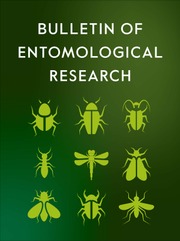Article contents
The Life-history of Tectacoris lineola, F., and its Connection with Internal Boll Rots in Queensland
Published online by Cambridge University Press: 10 July 2009
Extract
1. A general account is given of the habits and distribution of Tectacoris lineola, together with a description of the adult, and some remarks on the influence of weather conditions on mating.
2. The eggs and the different instars are described, and the period of time occupied by each is given.
3. The connection between Tectacoris lineola and boll rot incidence is established.
4. A table is given illustrating the comparative effect of boll rots and bollworm damage in the past season (1924–1925) on the Cotton Research Farm.
5. The effect of bug punctures on cotton seed and its infection with Fusarium moniliforme are briefly discussed.
Information
- Type
- Original Articles
- Information
- Copyright
- Copyright © Cambridge University Press 1926
References
* This blue form is var. tagalicus, Stål.
† After severe frost in 1924, adults were found lying dead in numbers, while nymphs were unharmed, though in another place after frost nymphs just hatching had been killed.
* Experiments made with a sterilised needle were inconclusive.
* This colour variation has been the cause of T. lineola having many synonyms. All kinds of colouration will be found in one brood.
* Cf. Withycombe, C. J., Bull. Ent. Res., xv, p. 171.Google Scholar
* The following fungi have been bred from samples of Queensland cotton, besides F. moniliforme : Aspergillus niger, A. flavus, A. nidulans, Cladosporium herbarium, Rhizopus arrhizus, and Alternaria sp.
† Identification kindly undertaken by the Imperial College of Science and Technology, on behalf of the Empire Cotton Growing Corporation.
* Kindly identified for me by Mr. Girault, Entomological Section, Department of Agriculture, Brisbane.
† Bred by F. G. Holdaway.
- 19
- Cited by

